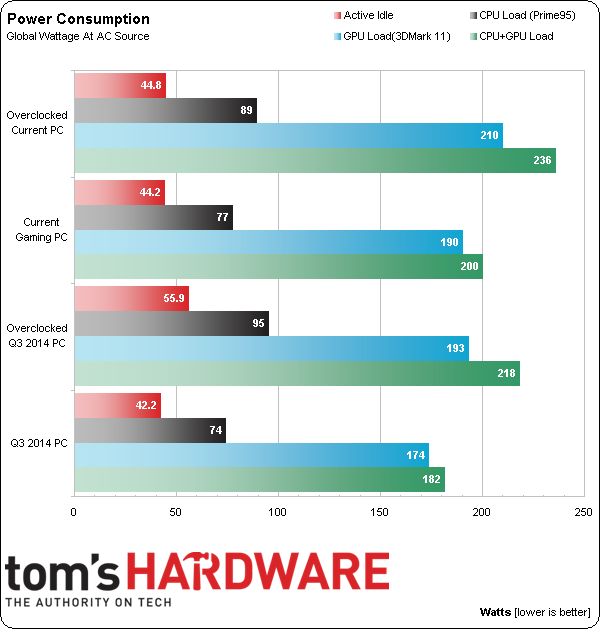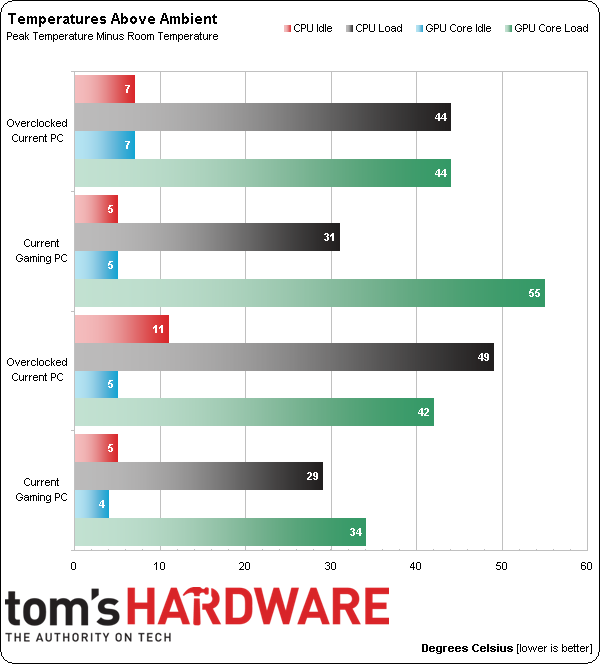System Builder Marathon Q4 2014: Budget Gaming PC
Power Consumption And Temperatures
Power Consumption
Processor power-saving features were enabled on both of the stock configurations. Both contain the same processor, motherboard, hard drives and optical drive. Both were outfitted with dual channel 8GB memory kits operating at DDR3-1333 @ 1.5V. And unlike the difference between Pitcairn HD 7870 vs. HD 7850, these two Curacao–based GPUs are both fully enabled, the difference being in 3D clocks and default voltage under load. Since the two idled at the same 300MHz Core, 150MHz memory, and at 0.875V, their consumption in that state should be roughly the same. At idle, what basically sets the rigs apart is the power supply and the number (and draw) of the cooling fans.
Under loads, our new Pentium defaulted to a lower VID of 1.065V, where last quarter’s ran 1.075V. Only when we load the GPU would we expect this machine to consume more power; which it clearly does. Yet, our new system also consumes tow to three watts more at idle and under CPU loads. We could perhaps speculate that the Antec VP-450 is slightly more efficient than our current system’s EVGA 500W unit, at least at very low system draw.
While overclocking, I left EIST (Enhanced Intel SpeedStep Technology) enabled this quarter, kept the CPU voltage lower, and ultimately came up 100MHz shy. The result is a reduction in consumption at idle and during CPU loads compared to last quarter. Under full GPU loads, our new system consumed more power. Last quarter’s R9 270 only came up 90MHz shy of matching this R9 270X, but I had ultimately bumped it’s GPU up 0.025V higher to get it there. The math doesn’t seem to quite add up, so we have to wonder how much the efficiency of the two power supplies is coming into play.
It’s worthy of mention that ambient room temperatures during these measurements were about six degrees Celsius cooler this quarter, and subsequently our component temperatures were also lower. We subtract the room temperature, ultimately finding the processors and graphics cores consistently idled about five degrees above ambient. Under loads, our new machine’s Pentium rose two degrees higher. While we didn’t maintain a controlled baseline temperature, there’s still a good chance this increase is from the smaller enclosure and reduced air flow. Milder overclocking at lower voltage then kept our new Pentium running cooler than last quarter’s, despite the smaller enclosure.
By default, MSI’s two 100mm fans were tuned to be quiet, topping out at only 21 percent duty cycle during a 10-minute long Far Cry 3 burn test. Even if the GPU was running within reason, I prefer a bit more airflow when tinkering with GDDR5 clocks. I manually played with the fan finding it quiet up to 40 percent, but clearly audible by 50 percent. I set up a custom profile to ramp up a little earlier, hitting 40 percent just below 70 degrees. This was a perfect blend of noise, cooling performance, and peace of mind, that ultimately kept our overclocked GPU core running much cooler than defaults.
I enjoy gaming through a Logitech 5.1 speaker system. However, I’m prone to immersion loss at the slightest distraction, and a noisy gaming box would have me exclusively switching to my Seinnheiser gaming headset instead. So I found it pleasing that both of these Pentium-based gaming rigs put out relatively low noise levels, and were absence of any annoying fans or coil squeal.
Get Tom's Hardware's best news and in-depth reviews, straight to your inbox.
Current page: Power Consumption And Temperatures
Prev Page Results: Far Cry 3 And GRID 2 Next Page Performance Summary-
airplanegeek Why is the PSU fan facing up instead of down? Doesn't that affect the cooling of the PSU?Reply -
sea monkey Upon submission of the form:Reply
The Sweepstakes opens on September 23, 2014 12 noon PDT and closes on October 6, 2014 12 noon PDT.
Umm... -
pauldh Yes it would. And it is facing down, just hidden from sight in the photo. The PSU fan's venting holes are flush with (and actually a part of) it's shell.Reply -
Zeh Just a hint: you SHOULD be using an air conditioner so you can have the same room temperature over the year.Reply
Preferably one with Inverter technology, which will decrease the temperature delta (it doesn't start-stop once it reaches a given temperature threshold). -
Onus Hmmm, I see some kudos for the VP-450 in here, being remarkably efficient despite not being 80+ (it is disqualified for 80+ for not having Active PFC).Reply
Since the purpose of these SBM machines is (imho) to learn things, I would have liked to have seen a different mobo used, for comparison.
I appreciate the thoughtful approach to overclocking that was used here.
The only niggle I can't resist is the $18 for the optical drive. For months, I've been seeing one or another of them for around $13-$14. That seems a small thing, but that $4-$5 plus the leftover may have bought either a better cooler or a faster HDD.
-
sea monkey Replytotally disappeared from site
sight
while monitor temperatures
monitoring
to be sure it could bee done
be
none the less
nonetheless
it’s R9 270X graphics card
its
Yet, both machines share a similar weakness, they’re outfitted with a dual-core Pentium capable of juggling only two threads at a time.
comma splice
outputting to 3-panels
three panels
-
lesmore2222 I agree with cody. I really wanted to see the difference a r9 280 would make as well. This was just too similar to the last build. Should have bought the r9 280 anyway and fibbed on the price a little. ;)Reply -
ingtar33 ReplyA final thought to consider is at what point will the next big game on your radar force an early upgrade to Core i5? It might not be too far off, as Far Cry 4, which launched a week after we ordered this machine, completely lacks official support for dual-threaded processors.
same with the game of the year, Dragon Age Inquisition.
I suspect it's time to drop dual cores as a build suggestion. -
BoredSysAdmin Great build. I would probably never built it exactly like the article (more ram, sdd - etc), but it provides great bones to build upon.Reply


